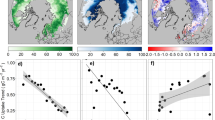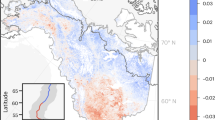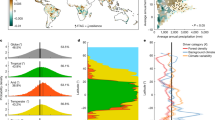Abstract
Planting trees has become a popular solution for climate change mitigation, owing to the ability of trees to accumulate carbon in biomass and thereby reduce anthropogenic atmospheric CO2 enrichment. As conditions for tree growth expand with global warming, tree-planting projects have been introduced in regions of the highest northern latitudes. However, several lines of evidence suggest that high-latitude tree planting is counterproductive to climate change mitigation. In northern boreal and Arctic regions, tree planting results in net warming due to increased surface darkness (decreased albedo), which counteracts potential mitigation effects from carbon storage in areas where biomass is limited and of low resilience. Furthermore, tree planting disturbs pools of soil carbon, which store most of the carbon in cold ecosystems, and has negative effects on native Arctic biota and livelihoods. Despite the immediate economic prospects that northern tree planting may represent, this approach does not constitute a valid climate-warming-mitigation strategy in either the Arctic or most of the boreal forest region. This has been known for decades, but as policies that incentivize tree planting are increasingly adopted across the high-latitude region, we warn against a narrow focus on biomass carbon storage. Instead, we call for a systems-oriented consideration of climate solutions that are rooted in an understanding of the whole suite of relevant Earth system processes that affect the radiative balance. This is crucial to avoid the implementation of ineffective or even counterproductive climate-warming mitigation strategies in the Arctic and boreal regions.
This is a preview of subscription content, access via your institution
Access options
Access Nature and 54 other Nature Portfolio journals
Get Nature+, our best-value online-access subscription
$32.99 / 30 days
cancel any time
Subscribe to this journal
Receive 12 print issues and online access
$259.00 per year
only $21.58 per issue
Buy this article
- Purchase on SpringerLink
- Instant access to full article PDF
Prices may be subject to local taxes which are calculated during checkout


Similar content being viewed by others
References
Bastin, J.-F. et al. The global tree restoration potential. Science 365, 76–79 (2019).
Investing in trees: global companies are protecting and restoring forests. World Economic Forum https://www.weforum.org/impact/investing-in-trees/ (2024).
Moyano, J. et al. Unintended consequences of planting native and non-native trees in treeless ecosystems to mitigate climate change. J. Ecol. https://doi.org/10.1111/1365-2745.14300 (2024).
Stevens, N. & Bond, W. J. A trillion trees: carbon capture or fuelling fires? Trends Ecol. Evol. https://doi.org/10.1016/j.tree.2023.09.015 (2023).
Parr, C. L., Beest, M. T. & Stevens, N. Conflation of reforestation with restoration is widespread. Science 383, 698–701 (2024).
Liu, H. et al. Nature-based framework for sustainable afforestation in global drylands under changing climate. Glob. Change Biol. 28, 2202–2220 (2022).
Briske, D. D., Vetter, S., Coetsee, C. & Turner, M. D. Rangeland afforestation is not a natural climate solution. Front. Ecol. Environ. 22, e2727 (2024).
Normand, S. et al. A greener Greenland? Climatic potential and long-term constraints on future expansions of trees and shrubs. Philos. Trans. R. Soc. Lond. B Biol. Sci. 368, 20120479 (2013).
Dial, R. J., Maher, C. T., Hewitt, R. E. & Sullivan, P. F. Sufficient conditions for rapid range expansion of a boreal conifer. Nature 608, 546–551 (2022).
Girardin, M. P. et al. No growth stimulation of Canada’s boreal forest under half-century of combined warming and CO2 fertilization. Proc. Natl Acad. Sci. USA 113, E8406–E8414 (2016).
Pastick, N. J. et al. Spatiotemporal remote sensing of ecosystem change and causation across Alaska. Glob. Change Biol. 25, 1171–1189 (2019).
Dial, R. J. et al. Arctic sea ice retreat fuels boreal forest advance. Science 383, 877–884 (2024).
Governor Dunleavy signs carbon offset legislation. Government of Alaska https://gov.alaska.gov/governor-dunleavy-signs-carbon-offset-legislation/ (2023).
Carbon forestry. Doyon, Limited https://www.doyon.com/about/sustainability/carbon-forestry/ (accessed 21 October 2024).
Trees in Greenland. Greenland Trees https://greenlandtrees.org/ (accessed 21 October 2024).
Aðgerðaáætlun í loftslagsmálum 2018–2030 (Ministry for the Environment and Natural Resources, 2018); https://www.stjornarradid.is/library/01--Frettatengt---myndir-og-skrar/UAR/100918%20A%C3%B0ger%C3%B0a%C3%A1%C3%A6tlun%20LOKA_%20-%20Copy%20(1).pdf
Schuur, E. A. G. et al. Climate change and the permafrost carbon feedback. Nature 520, 171–179 (2015).
Palmtag, J. et al. A high spatial resolution soil carbon and nitrogen dataset for the northern permafrost region based on circumpolar land cover upscaling. Earth Syst. Sci. Data 14, 4095–4110 (2022).
Macias-Fauria, M., Jepson, P., Zimov, N. & Malhi, Y. Pleistocene Arctic megafaunal ecological engineering as a natural climate solution? Philos. Trans. R. Soc. Lond. B Biol. Sci. 375, 20190122 (2020).
Mueller, C. W. et al. Large amounts of labile organic carbon in permafrost soils of northern Alaska. Glob. Change Biol. 21, 2804–2817 (2015).
García-Palacios, P. et al. Dominance of particulate organic carbon in top mineral soils in cold regions. Nat. Geosci. 17, 145–150 (2024).
Mayer, M. et al. Tamm Review: Influence of forest management activities on soil organic carbon stocks: a knowledge synthesis. For. Ecol. Manage. 466, 118127 (2020).
Terrer, C. et al. A trade-off between plant and soil carbon storage under elevated CO2. Nature 591, 599–603 (2021).
Street, L. E. et al. Plant carbon allocation drives turnover of old soil organic matter in permafrost tundra soils. Glob. Change Biol. 26, 4559–4571 (2020).
Keuper, F. et al. Carbon loss from northern circumpolar permafrost soils amplified by rhizosphere priming. Nat. Geosci. 13, 560–565 (2020).
Sturm, M. et al. Winter biological processes could help convert arctic tundra to shrubland. BioScience 55, 17–26 (2005).
Kropp, H. et al. Shallow soils are warmer under trees and tall shrubs across Arctic and Boreal ecosystems. Environ. Res. Lett. 16, 015001 (2020).
Brodylo, D., Douglas, T. A. & Zhang, C. Quantification of active layer depth at multiple scales in Interior Alaska permafrost. Environ. Res. Lett. 19, 034013 (2024).
Hasler, N. et al. Accounting for albedo change to identify climate-positive tree cover restoration. Nat. Commun. 15, 2275 (2024).
Betts, R. A. Offset of the potential carbon sink from boreal forestation by decreases in surface albedo. Nature 408, 187–190 (2000).
Mykleby, P. M., Snyder, P. K. & Twine, T. E. Quantifying the trade-off between carbon sequestration and albedo in midlatitude and high-latitude North American forests. Geophys. Res. Lett. 44, 2493–2501 (2017).
Weber, J. et al. Chemistry–albedo feedbacks offset up to a third of forestation’s CO2 removal benefits. Science 383, 860–864 (2024).
Windisch, M. G., Davin, E. L. & Seneviratne, S. I. Prioritizing forestation based on biogeochemical and local biogeophysical impacts. Nat. Clim. Change 11, 867–871 (2021).
López-Blanco, E. et al. Towards an increasingly biased view on Arctic change. Nat. Clim. Change 14, 152–155 (2024).
Anderegg, W. R. L. et al. Climate-driven risks to the climate mitigation potential of forests. Science 368, eaaz7005 (2020).
Anderegg, W. R. L. et al. A climate risk analysis of Earth’s forests in the 21st century. Science 377, 1099–1103 (2022).
Walker, X. J. et al. Increasing wildfires threaten historic carbon sink of boreal forest soils. Nature 572, 520–523 (2019).
Prendin, A. L. et al. Immediate and carry-over effects of insect outbreaks on vegetation growth in West Greenland assessed from cells to satellite. J. Biogeogr. 47, 87–100 (2020).
Descals, A. et al. Unprecedented fire activity above the Arctic Circle linked to rising temperatures. Science 378, 532–537 (2022).
Loranty, M. M. et al. Spatial variation in vegetation productivity trends, fire disturbance, and soil carbon across arctic–boreal permafrost ecosystems. Environ. Res. Lett. 11, 095008 (2016).
Hély, C., Bergeron, Y. & Flannigan, M. D. Effects of stand composition on fire hazard in mixed-wood Canadian boreal forest. J. Veg. Sci. 11, 813–824 (2000).
Girardin, M. P., Ali, A. A. & Hély, C. Wildfires in boreal ecosystems: past, present and some emerging trends. Int. J. Wildland Fire 19, 991–995 (2010).
Iversen, C. M. et al. The unseen iceberg: plant roots in arctic tundra. New Phytol. 205, 34–58 (2015).
Ma, W. et al. Wintertime extreme warming events in the high Arctic: characteristics, drivers, trends, and the role of atmospheric rivers. Atmos. Chem. Phys. 24, 4451–4472 (2024).
Rantanen, M. et al. The Arctic has warmed nearly four times faster than the globe since 1979. Commun. Earth Environ. 3, 168 (2022).
Fisher, J. P. et al. The influence of vegetation and soil characteristics on active-layer thickness of permafrost soils in boreal forest. Glob. Change Biol. 22, 3127–3140 (2016).
Allen, M. R. et al. Net zero: science, origins, and implications. Annu. Rev. Environ. Resour. 47, 849–887 (2022).
Beest, M. T., Sitters, J., Ménard, C. B. & Olofsson, J. Reindeer grazing increases summer albedo by reducing shrub abundance in Arctic tundra. Environ. Res. Lett. 11, 125013 (2016).
Post, E. et al. Large herbivore diversity slows sea ice-associated decline in arctic tundra diversity. Science 380, 1282–1287 (2023).
Yu, Q., Epstein, H., Engstrom, R. & Walker, D. Circumpolar arctic tundra biomass and productivity dynamics in response to projected climate change and herbivory. Glob. Change Biol. 23, 3895–3907 (2017).
Simba, L. D. et al. Wilder rangelands as a natural climate opportunity: linking climate action to biodiversity conservation and social transformation. Ambio 53, 678–696 (2024).
Mardikian, L. & Galani, S. Protecting the Arctic Indigenous peoples’ livelihoods in the face of Climate change: the potential of regional human rights law and the law of the sea. Hum. Rights Law Rev. 23, ngad020 (2023).
Martin, M., Boucher, Y., Fenton, N. J., Marchand, P. & Morin, H. Forest management has reduced the structural diversity of residual boreal old-growth forest landscapes in Eastern Canada. For. Ecol. Manage. 458, 117765 (2020).
Pálsdóttir, A. E. et al. Subarctic afforestation: effects of forest plantations on ground-nesting birds in lowland Iceland. J. Appl. Ecol. 59, 2456–2467 (2022).
Kopnina, H., Zhang, S. R., Anthony, S., Hassan, A. & Maroun, W. The inclusion of biodiversity into Environmental, Social, and Governance (ESG) framework: a strategic integration of ecocentric extinction accounting. J. Environ. Manage. 351, 119808 (2024).
TNFD Global. Recommendationsof the Taskforce onNature-relatedFinancial Disclosures (TNFD, 2023).
Drupp, M. A. et al. Accounting for the increasing benefits from scarce ecosystems. Science 383, 1062–1064 (2024).
Lund, M. et al. Larval outbreaks in West Greenland: instant and subsequent effects on tundra ecosystem productivity and CO2 exchange. Ambio 46, 26–38 (2017).
Gould, W. A., Raynolds, M. & Walker, D. A. Vegetation, plant biomass, and net primary productivity patterns in the Canadian Arctic. J. Geophys. Res. Atmos. https://doi.org/10.1029/2001JD000948 (2003)
Epstein, H. E. et al. Dynamics of aboveground phytomass of the circumpolar Arctic tundra during the past three decades. Environ. Res. Lett. 7, 015506 (2012).
Shi, Z. et al. The age distribution of global soil carbon inferred from radiocarbon measurements. Nat. Geosci. 13, 555–559 (2020).
Betts, A. K. & Ball, J. H. Albedo over the boreal forest. J. Geophys. Res. Atmos. 102, 28901–28909 (1997).
Botkin, D. B. & Simpson, L. G. Biomass of the North American boreal forest: a step toward accurate global measures. Biogeochemistry 9, 161–174 (1990).
Ranson, K. J. et al. Mapping of boreal forest biomass from spaceborne synthetic aperture radar. J. Geophys. Res. Atmos. 102, 29599–29610 (1997).
Acknowledgements
This paper was conceived during a workshop in Greenland funded by NERC Arctic Office UK-Greenland Arctic Bursary 2023/2024. J.Å.K. was supported by the Carlsberg Foundation (CARBONZOO, grant no. CF23_0641) and SustainScapes – Center for Sustainable Solutions under Global Change (Novo Nordisk Foundation grant no. NNF20OC0059595). The work of M.M.-F. and J.T.K. is supported by NERC project NE/W00089X/1. I.C.B. and E.L.-B. received funding from the Nordic Borealization Network (project funded by NordForsk (project no. 164079)). E.L.-B. considers this study a contribution to GreenFeedBack (greenhouse gas fluxes and Earth system feedbacks) funded by the European Union’s HORIZON Research and Innovation programme under grant agreement number 101056921. M.L.M. and L.B.-P. were supported by the A. V. Jensen Foundation. We warmly thank Kangerlussuaq International Science Support for hosting the workshop in March 2024.
Author information
Authors and Affiliations
Contributions
All authors contributed to the initial conceptualization. J.Å.K. wrote the first version of the manuscript with substantial inputs from M.M.-F., and L.B.-P., I.C.B., I.B.D.J., J.T.K., E.L.-B., Y.M., M.L.M., C.W.M., E.P. and K.R. provided important inputs on subsequent versions. L.B.-P. made the illustration for Fig. 1. M.L.M. and J.T.K. provided photographs for Fig. 2a,b. J.Å.K. led the manuscript revisions with inputs from M.M.-F. Input and approval of the revised manuscript before resubmission was given by L.B.-P., I.C.B., I.B.D.J., J.T.K., E.L.-B., Y.M., M.L.M., C.W.M., E.P. and K.R. The author list is presented in alphabetical order, except for the first and last authors.
Corresponding authors
Ethics declarations
Competing interests
The authors declare no competing interests.
Peer review
Peer review information
Nature Geoscience thanks Edouard Davin, Birgit Wild and the other, anonymous, reviewer(s) for their contribution to the peer review of this work. Primary Handling Editor: Xujia Jiang, in collaboration with the Nature Geoscience team.
Additional information
Publisher’s note Springer Nature remains neutral with regard to jurisdictional claims in published maps and institutional affiliations.
Rights and permissions
Springer Nature or its licensor (e.g. a society or other partner) holds exclusive rights to this article under a publishing agreement with the author(s) or other rightsholder(s); author self-archiving of the accepted manuscript version of this article is solely governed by the terms of such publishing agreement and applicable law.
About this article
Cite this article
Kristensen, J.Å., Barbero-Palacios, L., Barrio, I.C. et al. Tree planting is no climate solution at northern high latitudes. Nat. Geosci. 17, 1087–1092 (2024). https://doi.org/10.1038/s41561-024-01573-4
Received:
Accepted:
Published:
Issue date:
DOI: https://doi.org/10.1038/s41561-024-01573-4
This article is cited by
-
China’s naturally regenerated forests currently have greater aboveground carbon accumulation rates than newly planted forests
Communications Earth & Environment (2025)
-
Assessing the climate benefits of afforestation in the Canadian Northern Boreal and Southern Arctic
Nature Communications (2025)
-
Albedo-driven hydroclimatic impacts of large-scale vegetation restoration should not be overlooked
Nature Water (2025)
-
Atmospheric chemistry enhances the climate mitigation potential of tree restoration
Communications Earth & Environment (2025)



